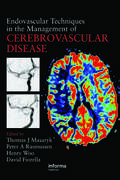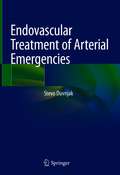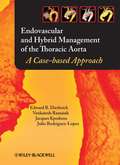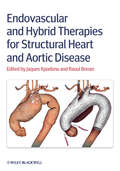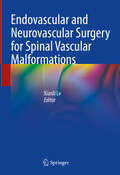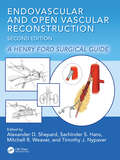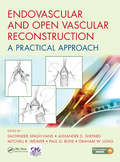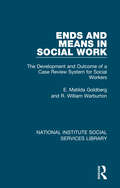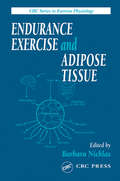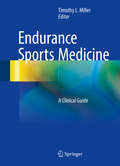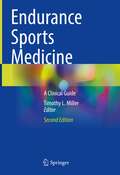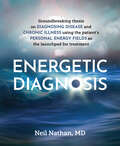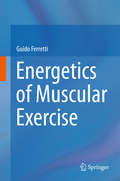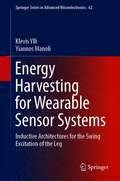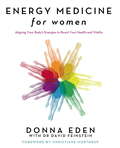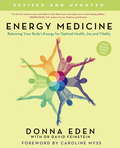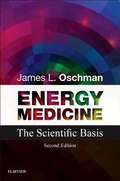- Table View
- List View
Endovascular Techniques in the Management of Cerebrovascular Disease
by David Fiorella Henry Woo Thomas J Masaryk Peter A RasmussenDirect from the Cleveland Clinic Foundation, Endovascular Techniques in the Management of Cerebrovascular Disease is intended for neurologists, neurosurgery fellows-in training, and practicing clinicians with an interest in endovascular procedures. This essential volume:Reviews equipment, devices, and therapeutic agents such as anti-coagulants and
Endovascular Tools and Techniques Made Easy
by Vikram S. Kashyap Matthew Janko Justin A. SmithThis practical resource shows the clinician how to handle and use the tools, devices, and implants required for endovascular interventions. A firm foundation in understanding the purpose, technical parameters, and function of each tool is required by vascular surgeons, interventional cardiologists, interventional radiologists, and other vascular specialists. Medical students, trainees, and physicians starting in practice will enhance their endovascular knowledge, which will allow for improved and seamless patient care. Even the experienced practitioner may find new tips in this book!
Endovascular Treatment of Arterial Emergencies
by Stevo DuvnjakThis book presents a practical overview of the widely used endovascular treatment of arterial emergencies, covering the majority of cases encountered in praxis. Including a wealth of high-quality images of arterial emergencies and treatment descriptions, it provides readers with essential information and shares insights into endovascular options. However, the book focuses on presenting common arterial emergencies from diagnosis to treatment only, without exhaustively describing all endovascular options. The clinical cases explore thoracic arterial emergencies, followed by abdominal emergencies and peripheral arterial emergencies. Rare clinical cases are also examined. The book offers interventional radiologists, vascular surgeons and cardiologists, as well as residents in these disciplines, a valuable tool for use in their everyday clinical praxis.
Endovascular and Hybrid Management of the Thoracic Aorta: A Case-based Approach
by Jacques Kpodonu Edward B. Diethrich Venkatesh Ramaiah Julio A. Rodriguez-LopezSurgical management of aortic pathologies has changed dramatically, and this essential book fills the void with up-to-date comprehensive information on the topic. Written by physicians at the Arizona Heart Institute, which pioneered the use of thoracic endoluminal grafts, Endovascular and Hybrid Management of the Thoracic Aorta presents clinical scenarios as well as controversies in this fascinating and rapidly developing field. Discussing the etiology, diagnostic tools and management and treatment of specific pathologies of the aorta, this book is ideal for cardiovascular and vascular surgeons from all over the world. It is also of interest to residents in vascular and cardiothoracic surgery who have an interest in thoracic aortic disease management and want to be at the forefront of endovascular technology.
Endovascular and Hybrid Therapies for Structural Heart and Aortic Disease
by Jacques Kpodonu Raoul BonanSaves Time and EffortFind everything you need on the most advanced treatments for aortic and structural heart disease in one easy-to-reference book - Procedure videos includedPercutaneous valve repair and replacement is one of the hottest topics in interventional cardiology. Substantial research has underscored the efficacy of emergent minimally-invasive procedures, and as a result percutaneous techniques are rapidly displacing surgical options as the treatment of choice for patients with aortic and structural heart disease. Until now, you have been forced to gather information about the latest advances in endovascular and hybrid therapies in piecemeal fashion, via journal articles or by attending seminars on individual techniques.Now, for the first time, you can get everything you need to add new techniques to your repertoire or achieve true mastery of procedures you have already begun to practice in one convenient book.Master Leading-Edge TherapiesPractical, Step-by-Step Guide to the Latest Endovascular and Hybrid TechniquesEdited by two of the most experienced practitioners in the field, Endovascular and Hybrid Therapies for Structural Heart and Aortic Disease covers everything interventionalists, radiologists, cardiac sugeons, and vascular surgeons need to know to master leading-edge therapies, including:Equipment selection and preparationExpert tips and tricks on individual therapiesUse of advanced imaging modalities like CT and real-time MRIOptimal management of complications and proper patient follow-upA review of the pertinent anatomy, information on patient evaluationComplex procedures and possible complicationsEssential hot topics: Hybrid Endovascular Aortic Arch Surgery, Technique of Thoracic Endografting for Thoracic Aneurysm using the Approved Gore TAG Device, Endovascular Robotics for Complex Aortic Intervention, and Transcatheter Closure of Mitral and Aortic Paravalvular Leaks, and more!Plus, each chapter is fully illustrated in color, and a companion website includes video clips of procedures covered in the text. Order your copy today!
Endovascular and Neurovascular Surgery for Spinal Vascular Malformations
by Xianli LvThis book introduces the great advances made in the techniques, devices and treatment concepts which benefit for spinal vascular malformations. It also covers several spinal vascular malformations that can be treated successfully with minimally invasive therapy.Spinal vascular malformations constitute rare pathological entities characterized by considerable angioarchitectural variation. Insufficient understanding of normal spinal vascular anatomy and abnormal vascular anatomy constituting these lesions restricts the development of surgical treatments specifically tailored to type of malformation. Spinal vascular malformation therapy should include conservative, microsurgical, endovascular, stereotactic, and/or multimodal therapy.Attendings, fellows, residents, medical students or anyone interested in sharpening their diagnostic and therapeutic skill set will benefit from reading this text.
Endovascular and Open Vascular Reconstruction: A Henry Ford Surgical Guide
by Alexander D. Shepard, Sachinder S. Hans, Mitchell R. Weaver, and Timothy J. NypaverDistilling a wide range of open vascular and endovascular reconstructive techniques into clear steps, this textbook provides insight and advice for vascular surgeons of all levels.Written by experts from the world-leading Henry Ford Vascular and Endovascular Surgery team, each chapter includes a discussion of the indications for and planning of each procedure, detailed technical steps, and multiple-choice questions to improve comprehension of the subject matter. Unique "Tricks and Traps" boxes highlight important tips for successful procedures and common pitfalls to avoid. Whether studying for an exam or as a quick review of procedural steps prior to heading to the operating room, the stepwise approach and clear illustrations help readers perform vascular operations with a clear understanding of anatomical exposure, dissection, and angiographic imaging. Vascular surgery trainees, junior and senior surgeons alike, will benefit from this practical advice when performing a wide range of vascular reconstructions. The collective expertise of the authors is invaluable to anyone looking to advance their understanding of the field.
Endovascular and Open Vascular Reconstruction: A Practical Approach
by Sachinder Singh Hans Alexander D. Shepard Mitchell R. Weaver Paul Bove Graham W. LongIn recent years, the growth in endovascular procedures has meant that vascular trainees may not gain sufficient experience to be competent in open vascular reconstructions following completion of their training. At the same time many senior surgeons have somewhat limited experience of endovascular techniques. This book will assist junior and senior surgeons and trainees in performing all types of vascular reconstructions. A key feature of the book is its clear illustrations, accompanied by pertinent case examples from vascular registries, so that readers can perform these operations with clear understanding of anatomical exposure and dissection, simplifying the conduct of the procedure.
Ends and Means in Social Work: The Development and Outcome of a Case Review System for Social Workers (National Institute Social Services Library)
by E. Matilda Goldberg R. William WarburtonOriginally published in 1979, Ends and Means in Social Work was the first book to provide research-based evidence on what social workers actually do, what they were aiming to achieve, and what sense their activities made, both in terms of their own subjective perspectives and those of their clients. The authors describe and analyse a series of surveys and action studies based on a year’s referrals and the long-term clientele of an area office. They aimed first to find out what the clients thought of and expected from the newly reorganised social services, and how social workers saw the changes and their new responsibilities. The second aim was to discover how social work skills and other resources were being used to meet different client needs. Third, the research was designed to enable social workers, by developing a new monitoring tool, the Case Review System, to become more explicit about both the ends and means of their activities. Widespread interest had been aroused by the Case Review System. It had raised intriguing questions about who gets what and why. On an individual level, the Case Review System can enable social workers to evaluate their practice by comparing plan with achievement; as an educational tool it can assist supervision; as a management tool it can provide aggregated data on client characteristics, the use of resources, and outcomes; as a research tool it can answer questions on the relationships between client characteristics, problems and social work practice, and provide longitudinal data on client careers. It is in response to insistent demands for a rounded account of this research project and its results that this book has been written. It endeavours to bring together all the aspects of the specific research studies and to discuss their wider implications for the organisation of the personal social services. Particularly valuable for students and practitioners alike will be the concluding discussion in which the evidence which emerged about the use of social work resources is subjected to critical review. Questions are raised about the current deployment of social work skills, and suggestions are made about how these skills might be redeployed, tasks defined more realistically, and how statutory functions could mesh more easily with voluntary activities.
Endurance Exercise and Adipose Tissue (Exercise Physiology)
by Barbara NicklasAdipose tissue, once considered inert connective tissue, is an essential storage site for key substrates used as sources of energy. In recent years, cellular and molecular biologists have advanced the concept that adipocytes are not solely a cellular storage location for excess fuel. Rather, adipose tissue is an active secretory organ that synthesi
Endurance Sports Medicine
by Timothy L MillerProviding comprehensive discussion of this newly developing branch of sports medicine, this unique and up-to-date book focuses specifically on the treatment of athletes who train for and participate in endurance sporting events, including not only traditional endurance athletes such as runners, swimmers, bikers and triathletes, but also rowers, adventure racers, military personnel, and cross-fit athletes. Detailing strategies for not only treating and preventing injuries and conditions but also for optimizing an athlete's performance, it is divided into three thematic sections. The first section covers common medical conditions faced by the endurance athlete, including cardiovascular conditions, asthma, and heat- and altitude-related illnesses, while also discussing gender differences, pregnancy and the pediatric endurance athlete. Section two focuses on the management of common musculoskeletal conditions, such as stress fractures, overuse injuries of the soft tissue, compartment syndrome, shoulder and hip injuries, and exercise and osteoarthritis. The last section presents special considerations for the endurance athlete, including gait and swim-stroke analysis, bike fitting, mental preparation, optimizing nutrition, and how to organize medical coverage for events, as well as decision-making for return to play. A timely topic and one which has not been written about extensively in one concise collection of chapters, Endurance Sports Medicine is a valuable guide for sports medicine physicians, orthopedists, athletic trainers, physical therapists, coaches, officials, and athletes in understanding the needs of the determined individuals who participate in endurance sports.
Endurance Sports Medicine: A Clinical Guide
by Timothy L. MillerProviding a fresh update of this continuously evolving branch of sports medicine, this comprehensive yet practical guide focuses specifically on the treatment of athletes who train for and participate in endurance sporting events, including not only traditional endurance athletes such as runners, swimmers, bikers and triathletes, but also rowers, adventure racers, military personnel and cross-fit athletes. Detailing strategies for not only treating and preventing injuries and conditions but also for optimizing an athlete’s performance, this book is divided into three thematic sections. The first section covers common medical conditions faced by the endurance athlete, including cardiovascular conditions, asthma, and heat- and altitude-related illnesses, while also discussing gender differences, pregnancy and the pediatric and masters endurance athlete. Section two focuses on the management of common musculoskeletal conditions, such as stress fractures, overuse injuries of the soft tissue, shoulder and hip injuries, and exercise and osteoarthritis; this section now includes discussion of the use of cutting-edge orthobiologics. The last section presents performance optimization and event coverage, including gait and swim-stroke analysis, bike fitting, resistance training, mental preparation, optimizing nutrition, and how to organize medical coverage for events, as well as decision-making for return to play. Completely updated and including brand new chapters, Endurance Sports Medicine, Second Edition remains a valuable guide for sports medicine physicians, orthopedists, athletic trainers, physical therapists, coaches, officials, and athletes in understanding the needs of the determined individuals who participate in endurance sports.
Enduring Cancer: Life, Death, and Diagnosis in Delhi (Critical Global Health: Evidence, Efficacy, Ethnography)
by Dwaipayan BanerjeeIn Enduring Cancer Dwaipayan Banerjee explores the efforts of Delhi's urban poor to create a livable life with cancer as patients and families negotiate an overextended health system unequipped to respond to the disease. Owing to long wait times, most urban poor cancer patients do not receive a diagnosis until it is too late to treat the disease effectively. Drawing on ethnographic fieldwork in the city's largest cancer care NGO and at India's premier public health hospital, Banerjee describes how, for these patients, a cancer diagnosis is often the latest and most serious in a long series of infrastructural failures. In the wake of these failures, Banerjee tracks how the disease then distributes itself across networks of social relations, testing these networks for strength and vulnerability. Banerjee demonstrates how living with and alongside cancer is to be newly awakened to the fragility of social ties, some already made brittle by past histories, and others that are retested for their capacity to support.
Energetic Diagnosis: Groundbreaking Thesis on Diagnosing Disease and Chronic Illness
by Neil NathanIn his new book Energetic Diagnosis, Dr Neil Nathan, renowned physician and bestselling author of TOXIC, delivers his groundbreaking thesis on diagnosing disease and chronic illness using the patient’s personal energy fields as the launchpad for treatment. An individual’s energy is often overlooked when treating difficult to identify disease. Dr. Nathan puts forth the premise that patient evaluation should be highly personal, beginning with a thorough analysis of events leading up to sickness, including lingering mental trauma. To do this, he urges medical professionals to use a process called Energetic Intuition—the ability to utilize pattern recognition presented by our own subconscious. In this book, Dr. Nathan details how he taps into his own intuition and learns to trust both himself and what the patient’s physical and mental state tell him. Dr. Nathan’s personal experience and years using this methodology has helped hundreds of patients understand their ailments and a find balance that helps them achieve optimal health. Energetic Diagnosis also features a robust detailing of how human energy is measured and perceived in a clinical setting using specific medical devices, interference fields and various autonomic response testing. Dr. Nathan invites guest doctors to detail the kinds of energy-focused treatments they use in their practices, such as A.R.T. (autonomic response testing), Kinesiology, and FSM (frequency specific microcurrents). Dr. Nathan concludes with important energetic considerations to open and build our awareness for a total, mind, body soul experience. He reveals the importance of dreams, native healing, communication with the natural world.
Energetic Kinesiology: Principles and Practice
by Charles Krebs Tania McGowanEnergetic Kinesiology is an emerging field internationally in the Complementary Health Sciences, gaining more and more scientific support and recognition. This fully referenced textbook describes the field and explains the techniques upon which it is built. It covers the underlying principles, the methods and scientific support for the efficacy of Energetic Kinesiology. It also offers a unique history of Energetic Kinesiology based on the first-hand experience of Charles Krebs who knew most of the originators of Energetic Kinesiology techniques personally. The book is a unique, well-illustrated, single source of a vast array of information, research and clinical knowledge in a format that is both accessible and practical to clinicians and students.
Energetics of Muscular Exercise
by Guido FerrettiThis book discusses the maximal power and capacity of the three major biochemical pathways - aerobic (oxygen consumption), anaerobic lactic (muscle lactate accumulation in absence of oxygen consumption), and anaerobic alactic (phosphocreatine hydrolysis) metabolism - as well as the factors that limit them. It also discusses the metabolic and cardio-pulmonary mechanisms of the dynamic response to exercise. The way and extent to which the power and capacity of the three major energy metabolisms are affected under a number of different conditions, such as training, hypoxia and microgravity, are also described.
Energy Balance and Gastrointestinal Cancer
by Nathan A. Berger Sanford D. MarkowitzThe gastrointestinal track provides one of the distinct systems where multiple malignancies, including adenocarcinoma of the pancreas, esophagus and colon are each associated with obesity. This unique association is covered in this volume of Energy Balance and Cancer from the epidemiologic, biologic and potential etiologic viewpoint. The focus on possible dietary contribution as well as the role of exercise in prevention and therapy is presented in both animal model and patient based studies. Special focus is provided also on the role of genetic mutations and inflammatory pathways as drivers of these obesity related gastrointestinal malignancies. Overall, this volume on Energy Balance and Gastrointestinal Malignancies should be valuable to Epidemiologists, Gastroenterologists and Oncologists, as well as to students and researchers from multiple disciplines interested in understanding and disrupting the association between obesity and cancer.
Energy Balance and Hematologic Malignancies
by Nathan A. Berger Steven D MittelmanThe obesity pandemic continues to increase on a world-wide basis with over 70% of the United States population being either overweight or obese. Hematologic malignancies have recently been identified among the obesity associated malignancies spanning the lifespan from childhood to the elderly and include leukemia, myeloma, lymphoma and others. In addition to the etiologic association between obesity and hematologic malignancies, the presence of obesity has profound effects on therapy by impacting pharmacokinetics of chemotherapeutic agents, dose, adipocyte metabolism and drug distribution. These may be particularly important in hematopoietic stem cell transplantation. Another important aspect of the association of obesity with hematologic malignancies is the increased incidence of obesity in children who successfully complete therapy for acute lymphoblastic leukemia. This and other observations indicate important relations between the hematopoietic systems and fat metabolism. This volume on Energy Balance in Hematologic Malignancies will provide an important volume in this series and a basis for better understanding etiology, mechanisms, therapeutics implications and experimental approaches. This volume of energy balance and cancer will focus on the relation of obesity to hematologic malignancies, the epidemiology, potential mechanisms, and thereapeutic considerations including effects on pharmacologic and physical approaches as well as the delayed effects of therapy on energy balance.
Energy Balance and Prostate Cancer
by Nathan A. Berger Elizabeth A. PlatzThis volume provides a comprehensive treatise on the latest studies linking prostate cancer with energy balance, which together constitute a major challenge and opportunity for research scientists and clinicians especially those dealing with the expanding population of older men confronted with obesity and associated comorbidities. This volume should be a valuable resource to physicians, oncologists, urologists, endocrinologists, nurses, nutritionists, dieticians, and exercise therapists dealing with men with energy balance issues and/or questions regarding the linkage between energy balance and cancer. Moreover, this volume should serve as an important resource for cancer researchers especially for scientists studying lifestyle modification and prevention strategies to better understand and disrupt the linkage between obesity and cancer.
Energy Balance in Motion
by Klaas R. WesterterpEnergy balance can be maintained by adapting energy intake to changes in energy expenditure and vice versa, where short-term changes in energy expenditure are mainly caused by physical activity. Questions are whether physical activity is affected by over and under-eating, is intake affected by an increase or a decrease in physical activity, and does overweight affect physical activity? Presented evidence is largely based on studies where physical activity is quantified with doubly labeled water. Overeating does not affect physical activity while under-eating decreases habitual or voluntary physical activity. Thus, it is easier to gain weight than to lose weight. An exercise induced increase in energy requirement is compensated by intake while a change to a more sedentary routine does not induce an equivalent reduction of intake and generally results in weight gain. Overweight and obese subjects have similar activity energy expenditures than lean people despite they move less. There are two options to reverse the general population trend for an increasing body weight, reducing intake or increasing physical activity. Based on the results presented, eating less is most effective for preventing weight gain, despite a potential negative effect on physical activity when reaching a negative energy balance.
Energy Harvesting for Wearable Sensor Systems: Inductive Architectures for the Swing Excitation of the Leg (Springer Series in Advanced Microelectronics #62)
by Yiannos Manoli Klevis YlliThis book investigates several non-resonant inductive harvester architectures in order to find the magnet coil arrangement that generates the largest power output. The book is useful as a step-by-step guide for readers unfamiliar with this form of energy harvesting, but who want to build their own system models to calculate the magnet motion and, from that, the power generation available for body-worn sensor systems. The detailed description of system model development will greatly facilitate experimental work with the aim of fabricating the design with the highest predicted power output. Based on the simulated optimal geometry, fabricated devices achieve an average power output of up to 43 mW during walking, an amount of power that can supply modern low-power, body-worn systems. Experiments were also carried out in industrial applications with power outputs up to 15 mW. In sum, researchers and engineers will find a step-by-step introduction to inductive harvesting and its modeling aspects for achieving optimal harvester designs in an efficient manner.
Energy Medicine For Women: Aligning Your Body's Energies to Boost Your Health and Vitality
by Donna Eden David FeinsteinFor more than three decades, Donna Eden has been teaching people to understand the body as an energy system, to recognize their aches and pains as signals of energy imbalance, and to reclaim their natural healing capabilities. In her long-awaited new book, Donna speaks directly to women, showing them how they can work with energy to tackle the specific health challenges they face. She reveals that a woman can manage her hormones by managing her energies and also use energy medicine to treat a host of health issues. From PMS to menopause, from high blood pressure to depression, the book offers easy-to-follow solutions to women's health issues that traditional medicine often fails to provide. Blending a compassionate voice with a profound grasp of how the female body functions as an energy system, Eden presents what is sure to become a classic book on the subject of women's health.
Energy Medicine For Women: Aligning Your Body's Energies to Boost Your Health and Vitality
by Donna Eden David FeinsteinFor more than three decades, Donna Eden has been teaching people to understand the body as an energy system, to recognize their aches and pains as signals of energy imbalance, and to reclaim their natural healing capabilities. In her long-awaited new book, Donna speaks directly to women, showing them how they can work with energy to tackle the specific health challenges they face. She reveals that a woman can manage her hormones by managing her energies and also use energy medicine to treat a host of health issues. From PMS to menopause, from high blood pressure to depression, the book offers easy-to-follow solutions to women's health issues that traditional medicine often fails to provide. Blending a compassionate voice with a profound grasp of how the female body functions as an energy system, Eden presents what is sure to become a classic book on the subject of women's health.
Energy Medicine: How to use your body's energies for optimum health and vitality
by John Feinstein Donna EdenDonna Eden is a pioneer in the field of energy medicine. In this important book she shows you how to work with you body's energy to create physical, psychological and spiritual health and wellbeing. Discover how to:* Bring more energy and vitality into your everyday life* Use simple techniques to overcome tiredness and lethargy* Cure common complaints and prevent disease* Work with the eight major energy systems of the body for health and healing* Heal your mind, body and soulEnergy medicine is a beautifully written, step-by-step approach for everyone who wants to achieve a healthier body, a sharper mind and a more joyful spirit.
Energy Medicine: The Scientific Basis
by James OschmanSee how energy therapies can normalize physiology and restore your patients' health! Energy Medicine: The Scientific Basis, 2nd Edition provides a deeper understanding of energy and energy flow in the human body. Using well-established scientific research, this book documents the presence of energy fields, discerns how those fields are generated, and determines how they are altered by disease, disorder, or injury. It then describes how therapeutic applications can restore natural energy flows within the body. Written by recognized energy medicine expert Dr. James Oschman - who is also a physiologist, cellular biologist, and biophysicist - this resource shows how the science of energetics may be used in healing diseases that conventional medicine has difficulty treating.
